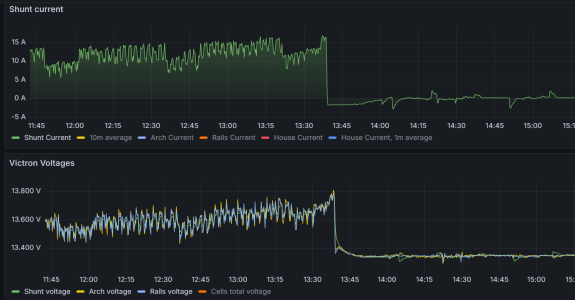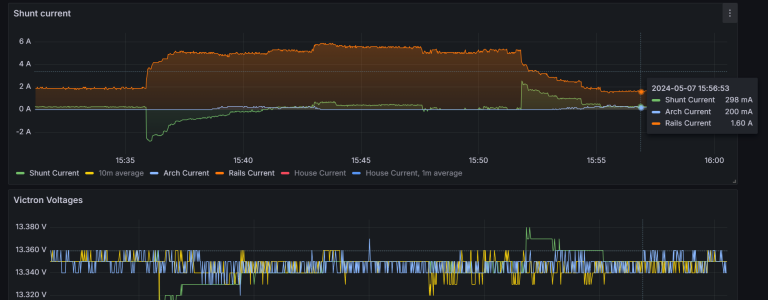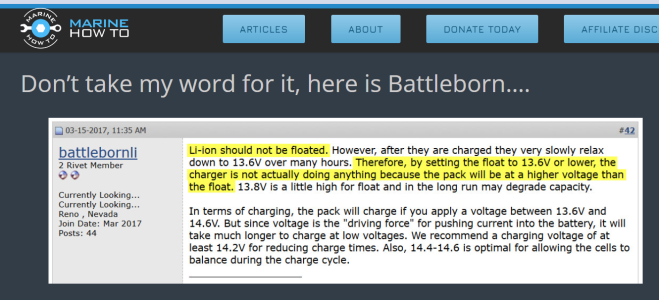GHA
Well-known member
Which is lots more than none at all.A statistical sample of 1.
And very reliable test data.
Which is lots more than none at all.A statistical sample of 1.
Mine are 13.8v absorption with no duration so goes straight to float which is 13.35v. The mppt voltage bluetoothed to the shunt actually lags the smartshunt voltage a little so will "catch up" when the fridge runs.@geem. Have you documented your charge settings anywhere? I recently upper by float settings to 13.4V as my Victron MPPt would default to float and put nothing in (like 2A from 15A possible).
Would be interested in what your using.
PS i store mine at 13.2V over winter.

At 13.35v I will have usually round about 250mA going into the LiFePo4, then when the fridge cycles on there will be a draw and the smartsolar MPPT ramps up the current output from the panels to cover that, when the fridge turns off again there is a lag as the smartsolar ramps the current down again over a few minutes.hm,
I also go up to 27,7V when charging (13,85V for 4cell banks) there it tapers off, stays on 27V (13,5V ) float for 30mins and then BMS wont let anything in the cells. No current whatsoever.

OK, I get that, so you're happy to have the mppt pumping something to make up for the loss of the fridge cycling and keep them effectively at 98 or so SoC for say an afternoon?At 13.35v I will have usually round about 250mA going into the LiFePo4, then when the fridge cycles on there will be a draw and the smartsolar MPPT ramps up the current output from the panels to cover that, when the fridge turns off again there is a lag as the smartsolar ramps the current down again over a few minutes.
The voltage is relatively low per cell compared to 3.65v & all the papers & research I've come across seem to be OK with that, as soon as the voltage hits 13.8v it goes down. All "float" does is just mostly keeps up with the house loads apart from a tiny bit out/in as the mppt react slow. Too small to show up on the 0.1% resolution of SOC from the smartshunt. Almost identical setting to Rod Collins 15 year olds & he said just had them 2 years straight on float at 13.5v so seems OK. It's quite tricky as there basically is no data whatsoever, apart from this video now, about running LiFePo4 long term on a boat, not enough time gone by yet.OK, I get that, so you're happy to have the mppt pumping something to make up for the loss of the fridge cycling and keep them effectively at 98 or so SoC for say an afternoon?
[I'm assuming you reach full charge on a day at midday, not running anything heavy and till the solar goes to sleep, so you have 5-7h fully charged]
thought it was bad practice so unless I do something that triggers a charging cycle, I'll keep them from midday till next morning without any input.

It's quite tricky as there basically is no data whatsoever, apart from this video now, about running LiFePo4 long term on a boat, not enough time gone by yet.
That's not how I see it. There's absolutely nothing wrong with running a solar/lithium system on land. But I seem to remember that you were weighing in on discussions without being open about that fact, and there are some fundamental differences between a marine system and a terrestrial one.If you recall I was heavily criticised for running a terrestrial Lithium power station- Rod is doing the same thing. I'm a pariah - he is to be copied. I'm in no way comparing - just saying
100%!!That's not how I see it. There's absolutely nothing wrong with running a solar/lithium system on land. But I seem to remember that you were weighing in on discussions without being open about that fact, and there are some fundamental differences between a marine system and a terrestrial one.
Several posters on here seem to have a bit of a bee in their collective bonnet about lithium, and will peddle easily disproved myths as a way of reassuring themselves that it's not worth the hassle to switch. Such myths include:
- lithium batteries are more expensive
- you'll have to rebuild your entire electrical system from scratch
- your boat will catch fire
- you can only use the 20-80% SOC range so there's barely any advantage over AGM
- you must install a huge inverter and electric galley
- you must install an arch and 1000s of watts of solar
As always happens on these threats, I will now be accused of being a zealot and claiming that lithium is the One True Way and anybody who chooses lead acid is a heathen. Which is nonsense, I still have four large lead acid batteries on my own boat, for engine start, windlass, and a handful of low power domestic circuits. If I wasn't bluewater cruising I might not have bothered to install lithium at all.
It's worth remembering these things when people mutter about how it was all so much better in the old days!100%!!
But for long term never plugged in cruising it really is impossible to overstate what a complete gamechanger LiFePo4 batteries are compared to lead acid. Life changing.
We got batteries that work, weather forecasts that are available & mostly pretty good, SasPlanet for sat images & charts, dyneema which doesn't break & makes great shackles, anchors which work, even starlink for watching silly cat videos in every anchorage if you want
It's all sooo much easier now
That's not how I see it. There's absolutely nothing wrong with running a solar/lithium system on land. But I seem to remember that you were weighing in on discussions without being open about that fact, and there are some fundamental differences between a marine system and a terrestrial one.
Why not go and do your own research, then post it on here with links to the sources.Are the batteries that he has been using for 15 years exactly the same as batteries now - have there been no developments.....in those ostensibly similar cells. Are the electronics he used 15 years ago, say 20 year old technology, the same as he is using now - has nothing changed?
Why not go and do your own research, then post it on here with links to the sources.
Fundamentally, it's about the level of redundancy and safety.So tell me - what are the differences with building a Lithium house bank on land and building the same arrangement on a yacht. What have I missed?
What are these fundamental differences.
Jonathan
not sure what SC had in mind, but since I'm currently designing a system for my home (in a city, with all services working, so no off-grid) I can list a few:And:
They are.....?
If you hit a reef or are run down by a tanker you will have problems within which Lithium will be a minor issue. I think I'm old enough to know of the constraints of space on a yacht. I have noted Geems consistent comment on fuses. I think on a yacht a skipper needs to take everything in terms of safety - very seriously.Fundamentally, it's about the level of redundancy and safety.
If you power your whole boat from lithium, including nav lights, autopilot, AIS, you need to be prepared for what you will do if the system shuts off. Not really a problem in a house, where you are unlikely to hit a reef or be run down by a tanker.
There may be more subtle differences in approach too, e.g. on land you have almost unlimited space for solar, whereas on a boat you are constrained. This will affect the choice of panels and possibly how you arrange them (series vs parallel).
In a house you could sit the whole thing in a shed some distance away, which may lead you to make different choices about safety margins for things like cables and fuses. On a boat it's sensible to take these things extremely seriously.
That's a shame. I'll try to boil it down.I am also here to learn but its becoming so confusing to me anyway that its all putting me off.
I would love a simple path forward with recommended sources of supply, but it may be too early in the process of development as definable setup
I'm not sure if you're being deliberately obtuse here. Maybe I wasn't clear enough? If your lithium system goes down on your yacht and you lose your lights, plotter, autopilot, etc, then things could quickly become more serious. You could, worst case, find yourself unlit and with no idea if where you or anybody else are. Which is where the reef, tanker, etc comes in. I was suggesting that these events would be an outcome of battery failure rather than a cause. I hope that is clear enough for you?If you hit a reef or are run down by a tanker you will have problems within which Lithium will be a minor issue.
A system designed for a yacht will work perfectly well on land, assuming you don't want grid connectivity. But a system optimised for land use may have different choices which don't transfer to use at sea. These have already been spelled out a couple of posts above, by myself and others, but just in case, it would primarily come down to choice/size/layout of the solar panels, because you don't have the same space constraints. A second point would be you safety margins. Absolutely nothing wrong with building to ABYC standards on land, but you could probably save some money if you chose to.I'm trying to find why building a Lithium house bank on land designed to be used on a yacht has fundamental differences to what I am doing.